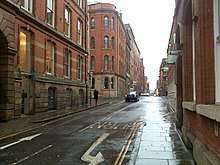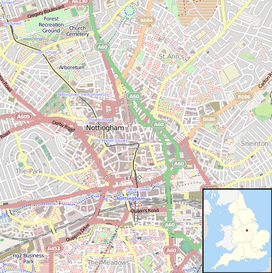Stoney Street, Nottingham
Stoney Street is an historic street in Nottingham City Centre between High Pavement and Carlton Street.
 Stoney Street, looking north | |
 Location within Central Nottingham | |
| Maintained by | Nottingham City Council |
|---|---|
| Coordinates | 52°57′6.65″N 1°8′33.72″W |
History
The street is medieval and formed the north to south spine of the Saxon town.[1]
For many years the street was a cul-de-sac, terminating before the current junction with High Pavement.[2] It was a residential street by the eighteenth century, containing some fine mansions including Plumptre House and Pierrepont House.
During the 19th century, the residential properties were replaced by Lace factories and these buildings still dominate the street.
Notable buildings
- 2 and 2A, 2 houses, early 19th century[3] Now houses and shops.
- 3, Warehouse, 1896 by Richard Charles Sutton[4] Now a fish bar.
- 7, Old Angel Public House, dated ca. 1800, then 1878 by Lawrence Bright, and 1883 by H Walker.[5]
- 8 to 14, Adams Buildings, 1855 by Thomas Chambers Hine[6]
- 16, Birkin Brothers Warehouse, 1872 by Robert Evans and William Jolley[7]
- 19, Warehouse, [8]
- 21 to 27, Warehouse, 19th century, with additions in 1910 by William Dymock Pratt[9]
- 34 and 34A, Eastgate House, Warehouse, 1850-60[10]
- 37, Warehouse, 1894 by John Howitt[11]
- 39, Warehouse, 19th century, altered in 1905 by Gilbert Smith Doughty[12]
- 47, Mills and Gibbs Warehouse, 19th century, altered in 1902 by Gilbert Smith Doughty[13]
- 49 and 51, Warehouse, 1883 by Richard Charles Sutton[14]
gollark: Maybe enchants, I guess? Shulker boxes? Floppy disks?
gollark: When would you need NBT matching though?
gollark: Can someone link me that comparison table?
gollark: There isn't really one.
gollark: *Try Xenon, and your shop will suddenly produce 1 million krist per hour - or your money back!*
References
| Wikimedia Commons has media related to Category:Stoney Street, Nottingham. |
- Harwood, Elain (2008). Pevsner Architectural Guides. Yale University Press. p. 103. ISBN 9780300126662.
- Holland Walker, J (1927). "An itinerary of Nottingham". Transactions of the Thoroton Society. 31: 6. Retrieved 31 December 2017.
- Historic England, "2 and 2A, Stoney Street (1059029)", National Heritage List for England, retrieved 2 January 2018
- Historic England, "3, Stoney Street (1270423)", National Heritage List for England, retrieved 2 January 2018
- Historic England, "Old Angel Public House (1255184)", National Heritage List for England, retrieved 2 January 2018
- Historic England, "Adams Building and attached railings (1270430)", National Heritage List for England, retrieved 2 January 2018
- Historic England, "16, Stoney Street (1255217)", National Heritage List for England, retrieved 2 January 2018
- Historic England, "19, Stoney Street (1255178)", National Heritage List for England, retrieved 2 January 2018
- Historic England, "21 to 27, Stoney Street (1270423)", National Heritage List for England, retrieved 2 January 2018
- Historic England, "Eastgate House (1255180)", National Heritage List for England, retrieved 2 January 2018
- Historic England, "Price House (1270432)", National Heritage List for England, retrieved 2 January 2018
- Historic England, "39, Stoney Street (1270423)", National Heritage List for England, retrieved 2 January 2018
- Historic England, "47, Stoney Street (1270423)", National Heritage List for England, retrieved 2 January 2018
- Historic England, "49 and 51, Stoney Street (1270433)", National Heritage List for England, retrieved 2 January 2018
This article is issued from Wikipedia. The text is licensed under Creative Commons - Attribution - Sharealike. Additional terms may apply for the media files.